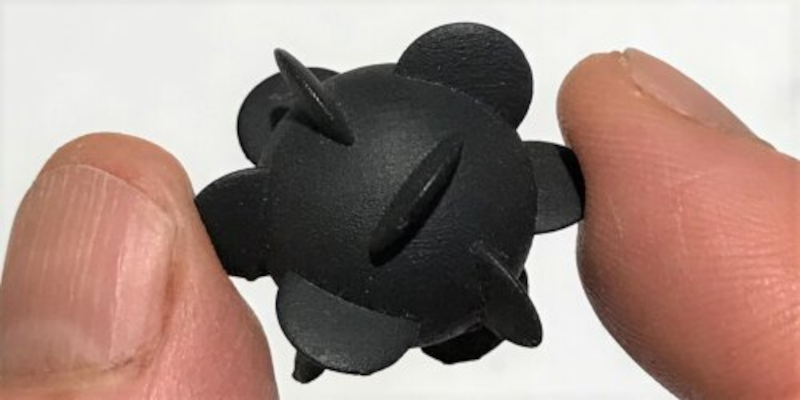If you think 3D printing is only good for benchies, key chains, and printer parts, you might enjoy the paper by two physicists from Wesleyan University and the University of Gothenburg. Lord Kelvin — also known as William Thomson — hypothesized a shape known as an isotropic helicoid. As its name implies, the shape would look the same from any angle. Kelvin predicted that such a shape would spin as it sank in a liquid. Turns out, 3D printing proves it wrong. (The actual paywalled paper is available.)
It might seem strange that scientists are only now getting around to disproving a 150-year old hypothesis. However, the paper’s authors think Kelvin may have built the structures — he provided precise instructions — and simply dropped it when it proved incorrect.
However, Kelvin wasn’t totally wrong. The shape of the helicoid does transmit linear force into rotation. It just isn’t sufficient to cause the shape to rotate. The team intends to try some similar shapes to see if Kelvin might be onto something.
We’ll be honest — we aren’t sure what the practical application of such a shape might be other than just scientific curiosity. But we were interested that 3D printing makes testing something like this much easier and allows incremental changes to the test shapes very quickly, something that would not be true in Kelvin’s day.
Lord Kelvin shows up in the strangest places. We’ve seen him in long-distance cables and electrostatic generators, among other things.

















“If you think 3D printing is only good for benchies, key chains, and printer parts…”
I notice quite a few 3D printer HaD articles start out like that and it gives the impression that the author/editor doesn’t really know much about 3D printing, and that the audience won’t know much either, and most 3D printer owners can’t think of anything to print with it other than trinkets. While I’m sure they are some people is those camps (e.g. just bought/gifted a 3D printer, still figuring out what it can do), it really seem to diminish the 3D printers value and place in the world.
Maybe next time try:
“If you think 3D printing is only good for benchies, key chains, houses, bridges, replacement organs, automotive parts, rockets engines, guns, medical devices, drones, rapid prototyping, ………”
This guy prints…
Actually, I wonder why anyone still thinks of 3D printing as “special” or “high tech” or “hacky”.
3D printing has been around for decades and is now just another method of manufacture. HaD never has articles on most other types of manufacture, such as “Artist creates candle by carving with car key!!” Of course they wouldn’t, it is just a mediocre tool used in a unusual, but unimportant, manor. 3D printing is now just another tool in the chest, no more important than the others.
While I understand most people, even readers of this site, haven’t ever seen an in-person 3D printer, that doesn’t make it the end-all-be-all that this site tries to make it.
3D prints usually suck at strength, durability, weight, and looks. The only real advantages they have are initial price, speed of prototyping, and accessibility.
3D printing in the hobby space is barely a decade old. 3D Systems and Stratasys had a stranglehold on the whole thing until critical patents either expired or were circumvented. it’s only in the past five years that it’s come down in price to where your average po’boy hacker can do more than sneeze in the direction of a decent printer.
Now get down off your high horse and roll around in your failed prints like the rest of us
“Now get down off your high horse and roll around in your failed prints like the rest of us”
::looks at 5 gallon bucket filled with support material and failed prints with lots of sharp corners:: that sounds painful. :D
thought about shredding them and trying to grow weed in the resulting shreds. nothing ever came of that project. and 5 gallons of failed prints and deprecated designs ended up in the dumpster.
I can’t answer to LordNothing directly (because of the nesting level?) … but why would somebody grow … plants … in shredded 3d prints? Because PLA is “biocomposable” (which is it not in practice?).
Metal smelting has been around for thousands of years, surely you are making your own horseshoes and silverware by now. I know it’s only been about 500 years but what is your excuse?
While your obvious acerbity is disturbing, I find myself unable to comply with your request. If you are dealing with that many “failed prints”, there is something wrong with your process. I may have a few prototypes that did not meet my needs, but they were spot on with the design. Perhaps learn a bit more about your machine tool and how it operates, this is not some Star Trek “Replicator”, maybe learn a bit more about the material science of the filament so you understand what parameters like temperature, speed, and flow rate mean for a print. If you are unhappy with the quality, learn what accel, decel, jerk, and jitter do. I built my first “hobby” printer in 2008 which by any measure is over a decade ago. A 3D printer is a machine tool that needs to be set-up properly, squared, and tightened. After that, part quality is generally in the hands of the operator, just like in the rest of the machine tool industry. Getting all “salty” and making excuses, does absolutely nothing to get better prints and fewer “Failed prints”
The reason FDM gets so much attention (here and on other sites on the internet) is because it’s easier to go from a computer programming/electronics/techy background into using FDM vs other fabrication techniques (welding, milling, working with sheet metal etc.).
Exactly. I use it constantly and 3D printing has become an almost indispensable tool in almost every field of engineering. Pretty much any company that designs anything which can be represented in hard material uses them. It’s gone from a novelty to a thing where when the 3D printer is down everyone is in a hurry to get it going again.
Yeah, it’s kind of a tired cliche if you ask me. But Al’s got a (few) 3D printers, and he enjoys hacking on them.
Disproving Lord Kelvin? That’s cold, -273.15C degrees cold!
You are underappreciated.
Yep, my EGO tells me that every day too.
So what does it do above mach 1 in that fluid we call air?
I considered that perhaps they didn’t let it flow in that liquid long enough. Also, which direction should gravity be working on it as it moves? One last thing, mathematically speaking, it doesn’t matter if the fluid or the object is moving, the forces should be the same. I should go read the paper.
Well if you have a 3D printer and, after reading the paper, you disagree with their results or methodology you could try it yourself?
https://arxiv.org/pdf/2006.08282v2.pdf
What most upset me is the the fact the paper lies behind a paywall when it was probably done with government funding somewhere along its evolutionary path. Maybe the author thinks this will lead to the newest fusion.
Well the first university is a private one while the other is in Sweden.
Most of the papers in top rated journals will be paywalled unless the author paid the journal thousands of dollars to make the paper open access. Authors don’t lock up the papers on purpose.
Exactly this^
The final paper is paywalled but it was first published on arXiv: https://arxiv.org/pdf/2006.08282.pdf
You’re welcome…
Thanks for that link.
Here is a version on thingiverse to play with…
https://www.thingiverse.com/thing:4919640
This line from the article was driving me batty:
“As its name implies, the shape would look the same from any angle.”
It obviously does not look the same from any angle.
This description from the paper makes much more sense:
“Lord Kelvin commented on a particular shape, the isotropic helicoid, which experiences the same translational resistance in a homogeneous fluid flow at any orientation, just like a sphere.”
It doesn’t look the same when viewed from any direction. It reacts the same when moving through a fluid, regardless of orientation
thank you
Amazed that such disruptive innovative and paradigm shattering tech still used to make knick Knacks and Doo dads